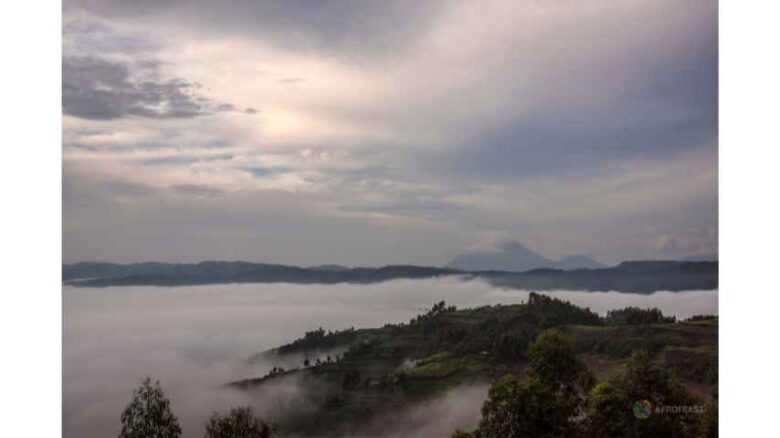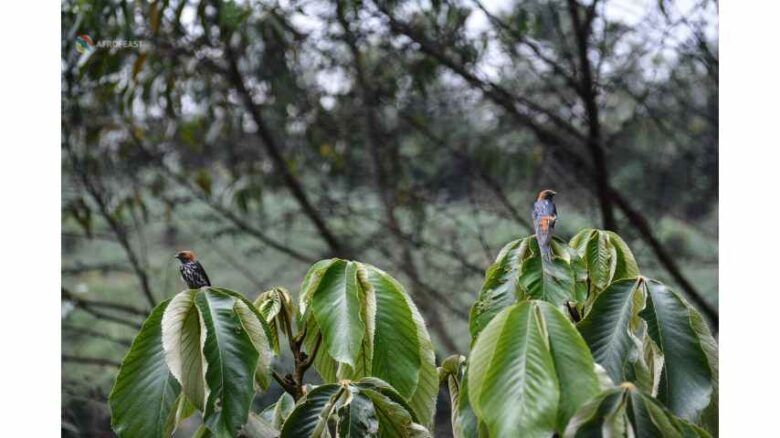Bwindi Impenetrable National Park
Did you know that Bwindi Imprenetrable National Park is recognised by UNESCO as a biodiversity hotspot with more than 160 tree species, and over 100 species of ferns? It gets better, you can also find a variety of birds, endemic butterflies and a rich variety of mammals. However, that’s not the reason we love Bwindi, it’s the endangered species of mountain gorillas.
Known for its exceptional biodiversity, this wonderful place is located in the southwestern part of Uganda, the pearl of Africa. Scientists consider Bwindi Impenetrable National Park a relic from the Ice Age era. They say it’s a surviving piece of a once-vast forest devouring the Western part of Uganda, Rwanda, Burundi, and the Democratic Republic of Congo.
Here is another fun fact – almost half of the world’s mountain gorilla population — 1,067 individuals call Bwindi home. That makes it a stronghold for conservation. Despite its isolation, this forest is surrounded by agriculture, which highlights the delicate balance between human needs and preservation. In addition to gorilla trekking tourism, ecotourism underlines this community’s commitment to harmonious coexistence.

The Impenetrable’s Symphony of Natural Beauty

Imagine a place where jungles erupt in a vibrant chorus of colour, where hidden waterfalls serenade the air with a gentle roar, and each twist and turn unveils a breathtaking experience in nature. Trust us, this is not a figment of your imagination, it’s a captivating reality.
Landscape & Scenery
Bwindi Impenetrable National Park lives up to its name. Its centrepiece is the dense tropical rainforest, where life flourishes in shades of vibrant green. The lush foliage forms a sanctuary of sorts for countless species while fostering an ecosystem teeming with life.

This vast stretch of mist-covered mountains features a dense, primaeval rainforest. The tall towering trees, form shades of vibrant green. And that’s not all – the river’s crystal-clear waters reflect its beauty, and breathtaking landscape that carves through the park.
These waterways also add to the aesthetic charm of the park, and provide a vital lifeline for those that call Bwindi home. It gets better – the gentle flow of these waters encourages moments of reflection and allows visitors to appreciate the delicate balance between land and water.
Did you know that one of the most captivating features of Bwindi’s landscape is the persistent mist that covers the forest, literally? This mist weaves through trees and hills, creates a conducive atmosphere that adds a sense of mystery and enchantment to the surroundings.
A Treasure Trove of Biodiversity
Did you know that Bwindi Impenetrable Forest is world-renowned as one of the last strongholds of Africa’s majestic mountain gorillas? Bwindi, is an ancient wonder and is home to approximately half of the world’s critically endangered mountain gorilla population.
Imagine if you got the opportunity to encounter these incredible creatures in their natural habitat. Guaranteed, this once-in-a-lifetime experience will leave you with a profound and lasting impact.
The best part? The park rangers ensure that visitors can have this wonderful experience with the gorillas in small groups, without disturbing them. If you plan to go gorilla trekking, here’s what you will experience:
- A once-in-life time gorilla adventure!
- With the aid of a guide, you’ll hike through the forest with guides as you follow the gorillas’ tracks. It is a tough walk, but quite exciting too!
- Listen to bird calls of all kinds and immerse yourself into nature, as you hear leaves rustling.
And finally, when you find a gorilla family, time seems to stand still, literally. Imagine observing these magnificent creatures in their familial units, listening to bird calls, and experiencing just how therapeutic nature truly is.
You witness their social interactions. Occasionally you could catch playful juveniles swinging from branches or maybe a silverback’s calm, watchful gaze as he protects his group. Every moment, every gesture, presents a unique opportunity to socailize with these majestic creatures.
Note: It is paramount to note that very strict regulations are in place to ensure your safety and the well-being and conservation of these gorillas. That’s why only a limited number of permits are issued each day.
Every trek is carefully controlled to minimise any disturbance to the gorillas and their habitat. Additionally, to guarantee that future generations can encounter these extraordinary beings in their natural habitant, a conservation-focused approach is in place.
If you wish to experience what it’s like to encounter mountain gorillas, and have a transformative journey, you’re welcome to visit Bwindi Impenetrable National Park. Not only does this act foster a deep connection with these gentle giants but also educates you on the importance of their conservation.
Encountering these gorillas reminds us how much nature and humans are connected. Furthermore, it’s a collective responsibility to preserve and protect our planet’s most precious treasures.
Facts About Mountain Gorillas
- Did you know that we share about 98% of our DNA with gorillas? Thats right! And that means that exposure to human illnesses, – like a cold has potentially deadly impacts on gorillas because they are genetically similar to us.
- Did you know that gorillas are also one of the biggest, and most powerful primates alive today? Mountain gorillas are also the largest primates on Earth. Just their striking presence commands respect and awe. Despite their enormous size, gorillas are surprisingly gentle. Watching them so close is an unforgettable experience that even words can’t express.
- Did you know that an average mountain silverback gorilla weighs up to 180kg and measures 170cm (over 5’5”) tall on all fours? In contrast, female gorillas weigh about 90kg and measure up to 150cm (4’9”). Pretty cool, right?
While in the wild, mountain gorillas can live up to over 40 years. An infant gorilla is around three-and-a-half years old, and an adult at around eight years old. Male gorillas between 8-12 years old are referred to as ‘blackbacks’. And, finally, once they are 12 years of age, they develop that silver section of hair on their back and hips, and that’s how they earn the name ‘silverback’.
Conservation Efforts and Challenges
For the Trek:
- First, you must obtain a gorilla trekking permit well in advance due to their limited availability.
- Next, you must prepare for a physically demanding hike through rugged terrain (pack an extra pair of comfortable shoes).
- Experienced guides will lead you through the forest as they share their extensive knowledge about the park.
- Witnessing these majestic mountain gorillas in their natural habitat is an unforgettable experience, that’s for sure.
Responsible Tourism:
- You must follow strict guidelines set by park authorities to minimize disturbance to gorillas, and also ensure your safety.
- Respect the park’s environment.
- As a responsible tourist, consider supporting our lodges because they contribute to conservation efforts.
Beyond Gorillas:
- Bwindi boasts incredible biodiversity with diverse plant, bird and animal life.
- You must also explore the park’s various ecosystems, ie the waterfalls, swamps, and bamboo forests.
- Then you can also immerse yourself in the rich culture of our local communities that surround the park.
Experiencing the Magic of Bwindi (Activities)
Undoubtedly, a gorilla trek is the highlight of Bwindi. However, the park also offers a wealth of experiences to help you better understand its magic. Let’s explore the exciting activities that await you.
The Four Sectors of Bwindi Impenetrable National Park

Bwindi is divided into four sectors, with each offering a distinct gorilla trekking and nature hiking experience. Here is an overview of the four sectors:
The gorgeous views of Bwindi Impenetrable Forest from Ihamba Residence in Ruhija Sector
- Buhoma Sector Is located in the north of the park and is home to four habituated gorilla families. These include the Mubare, Rushegura, Muyambi, Habinyanja, and Katwe groups. Buhoma is the most popular gorilla tracking sector in Bwindi and it also offers a range of accommodation options.
- Ruhija Sector
Located to the eastern side of the park, Ruhija is home to three habituated gorilla families, and they include – the Oruzogo, Mukiza, Bitukura, and Kyaguliro groups. This sector is less crowded than Buhoma and offers really beautiful views of the park. - Rushaga Sector
Rushaga is located in the south and is home to five habituated gorilla families, which include the Nshongi, Busingye, Mucunguzi, Mishaya, Kahungye, Rwigi, Bikingi, and Bweza groups. The Rushaga sector is known for its very steep hills and is considered one of the most challenging gorilla tracking sectors.
-
Nkuringo Sector
Also located in the south, its home to three habituated gorilla families, the Nkuringo, Christmas, and Bushaho gorilla group. Nkuringo is known for its stunning views of the Virunga Volcanoes and Lake Mutanda.
Bwindi Gorilla Trekking Permits and Logistics
Note: Without a gorilla trekking permit, you can never visit Bwindi Impenetrable National Park. Let’s explore some necessary information about gorilla permits and park fees:
Just a limited number of gorilla trekking permits are issued daily to protect the gorillas and their habitat. This limitation ensures a controlled and sustainable tourism experience.
However, due to high demand, it’s advisable to book your gorilla trekking permits well in advance. It could be several months ahead before you obtain one and booking in advance helps to secure your permit and ensures availability.
Gorilla Habituation Experience:
Gorilla habituation permits are a tad bit more expensive than the regular gorilla permits because they allow you to spend not 1, but 4 hours with the gorillas. A gorilla permit costs $ 700 per person per trek to spend 1 hour with gorillas. In contrast, a gorilla habituation permit costs $1500 per person, per trek for 4 hours with the gorillas.
- Non-residents: $800 (as of April 15, 2024)
- Residents: $700
- East African Citizens: UGX 250,000 (roughly $70)
Note: If you wish to go for the gorilla habituation experience, that’s a separate program. This premium fee reflects the in-depth nature of your experience and allows visitors to spend more time with a habituated gorilla group.
Why the High Cost?
While these permit fees seem expensive, they play a pivotal role in funding a comprehensive gorilla conservation program. And that’s how this program benefits not just these majestic mountain gorillas but also the local communities surrounding the park, and finally, the entire ecosystem.
Typically, your gorilla trekking permit includes a guided experience. Visitors are also accompanied by armed rangers and trackers to ensure safety, guarantee and enhance your chances of encountering gorillas.
You can book your gorilla permit from the official Uganda Wildlife Authority or through a licensed tour operatorin Uganda.
Bottom Line
Bwindi Impenetrable National Park has stood the testament of time and the wonders of biodiversity. From the majestic mountain gorillas to the hidden vibrant ecosystems, it’s a place like no other and also inspires awe in the natural world. Bwindi is a crucial battleground for conservation efforts and it reminds us of our collective responsibility to always protect this irreplaceable treasure. Supporting Bwindi’s conservation efforts and initiatives, we ensure that future generations enjoy its symphony of nature.
